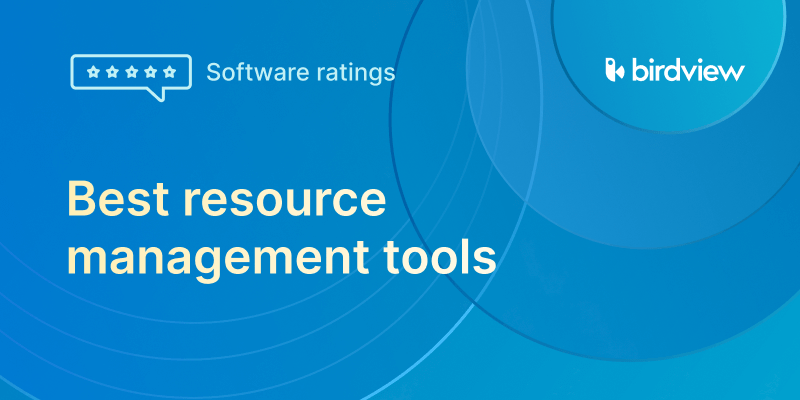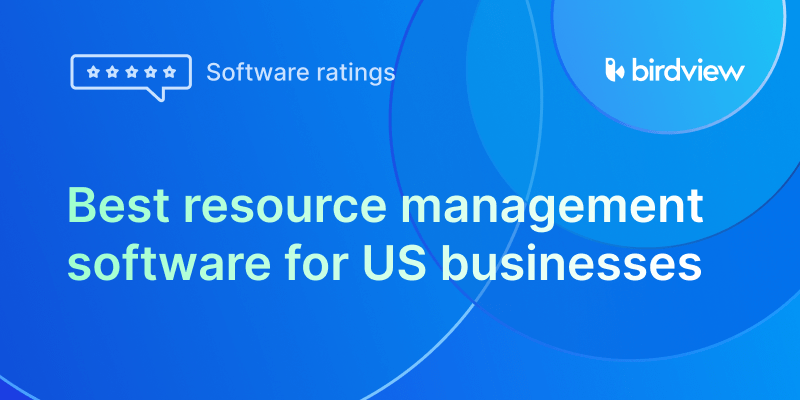Imagine managing a project where resources are perfectly aligned with your needs, deadlines are met effortlessly, and stress is minimized. Sounds ideal, right? Yet, resource constraints often stand in the way, turning project management into a juggling act.
This article aims to transform how you handle these challenges. We’ll explore the various types of resource constraints, their causes, and their impacts on your projects. You’ll learn effective techniques to identify and manage these constraints early on, practical tips to prevent them, and how Birdview can streamline your efforts.
What are resource constraints?
One of the most common challenges when managing a project is dealing with resource constraints. But what exactly does this mean? Resource constraints in project management refer to limitations on the availability and allocation of resources needed to complete a project. These resources can include people, money, materials, and time. You need to understand and address these constraints to keep your project on track and ensure its success.
Resource constraints types, their cause, and impact on project success
Resource constraints in project management arise when there is a mismatch between the resources required for a project and the resources available. These constraints can take many forms, each presenting unique challenges.
Let‘s take a look at each type of resource constraint, and its causes, and see their impact on the overall success of your project.
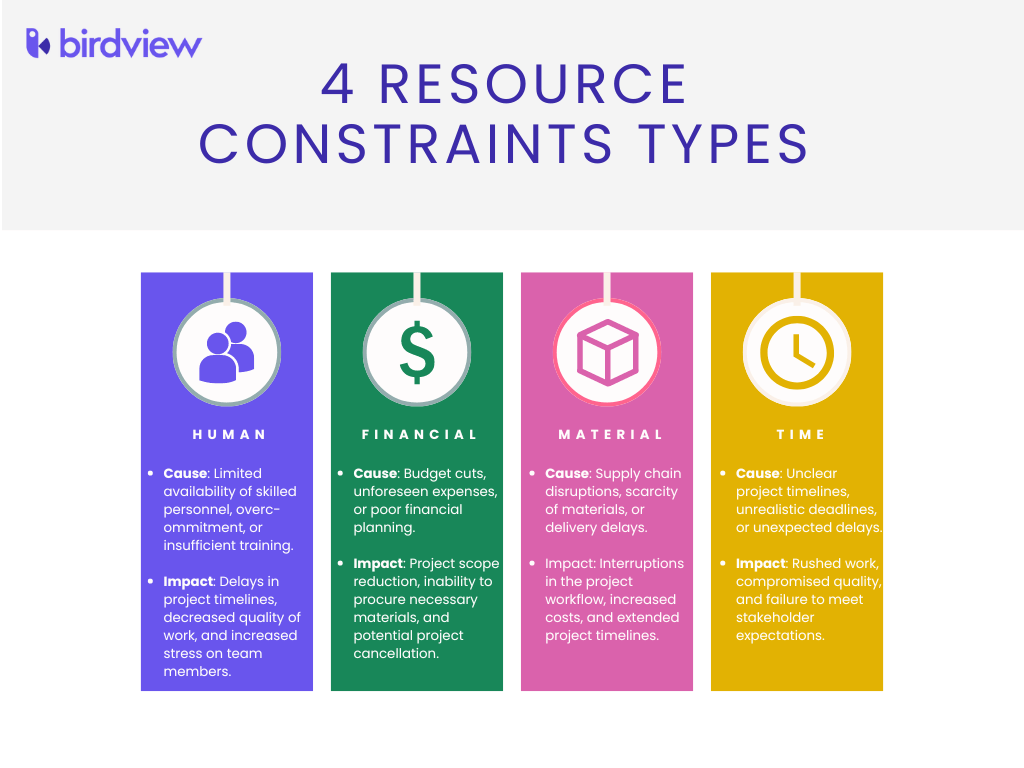
👥 Human resources constraints can involve not having enough team members, lacking specific skill sets, or having team members who are overcommitted to other projects. This can lead to delays, increased stress, and burnout, ultimately affecting the quality of the project deliverables.
❔ Cause: Limited availability of skilled personnel, overcommitment, or insufficient training.
📍 Impact: Delays in project timelines, decreased quality of work, and increased stress on team members.
💰Financial resources constraints occur when there is insufficient funding to cover project costs. This can happen due to poor budgeting, unexpected expenses, or changes in project scope. Financial constraints can force project managers to cut corners, reduce scope, or even halt the project entirely.
❔ Cause: Budget cuts, unforeseen expenses, or poor financial planning.
📍 Impact: Project scope reduction, inability to procure necessary materials, and potential project cancellation.
🧱 Material resources constraints involve the availability of physical items needed for the project, such as equipment, tools, or raw materials. Supply chain issues, vendor delays, or scarcity of materials can cause significant setbacks and increase project costs.
❔ Cause: Supply chain disruptions, scarcity of materials, or delivery delays.
📍 Impact: Interruptions in the project workflow, increased costs, and extended project timelines.
⏱ Time constraints refer to the limited time available to complete the project. Tight deadlines, unforeseen delays, and extended approval processes can compress the project timeline, leading to rushed work and compromised quality.
❔ Cause: Unclear project timelines, unrealistic deadlines, or unexpected delays.
📍 Impact: Rushed work, compromised quality, and failure to meet stakeholder expectations.
How to identify resource constraints: key techniques
Have you ever found yourself midway through a project only to realize you‘re short on crucial resources? Identifying resource constraints early can save you a lot of headaches down the road.
Here are some effective techniques to help you pinpoint resource constraints in project management early on. By being proactive and using these methods, you’ll be better equipped to keep your project running smoothly and on schedule.
Resource audits
Conduct regular resource audits to systematically review all resources allocated to your project. This process helps you identify any shortfalls or over-allocations. For example, you might find that certain team members are overbooked, or that you lack essential materials. Regular audits ensure that you have a clear understanding of your resource availability and can make informed decisions.
Stakeholder interviews
Engage with your team and other stakeholders through interviews to uncover resource constraints. By discussing their needs, challenges, and expectations, you can gain insights into potential issues that might not be immediately apparent. For instance, a team member might reveal that they are juggling multiple projects, or a supplier might inform you of potential delays in material delivery. These conversations provide a comprehensive view of the resource landscape.
Historical data analysis
Analyze historical data from similar past projects to gain informative insights. By examining patterns and trends, you can anticipate potential resource constraints in project management. For example, if previous projects experienced delays due to limited availability of skilled personnel, you can plan accordingly. This data-driven approach helps you foresee issues and develop strategies to address them before they impact your current project.
Resource management tools
Utilize resource management tools like Gantt charts, resource histograms, and project management software to streamline the process of identifying resource constraints. These tools provide a visual representation of resource allocation and availability, making it easier to spot imbalances. For instance, a Gantt chart within Birdview‘s resource management software can show you overlapping tasks that require the same resources, allowing you to adjust schedules and prevent conflicts.
4 strategies for managing resource constraints in project management
Feeling already overwhelmed by resource constraints? You’re not alone. Managing a project with limited resources can be incredibly challenging and stressful. But don’t worry–there are effective strategies to help you navigate these obstacles. With the right strategies, you can turn these obstacles into manageable tasks.
These four strategies will help you navigate resource challenges and achieve successful project outcomes.
1. Prioritize tasks and resources
Focus on prioritizing tasks and resources to ensure that the most critical elements of your project receive the attention they need. Start by identifying high-priority tasks that have the most significant impact on your project‘s success. Allocate your best resources to these tasks to ensure they are completed efficiently and to a high standard. For example, assign your most skilled team members to tasks that require specialized expertise, ensuring that these crucial parts of your project are executed flawlessly.
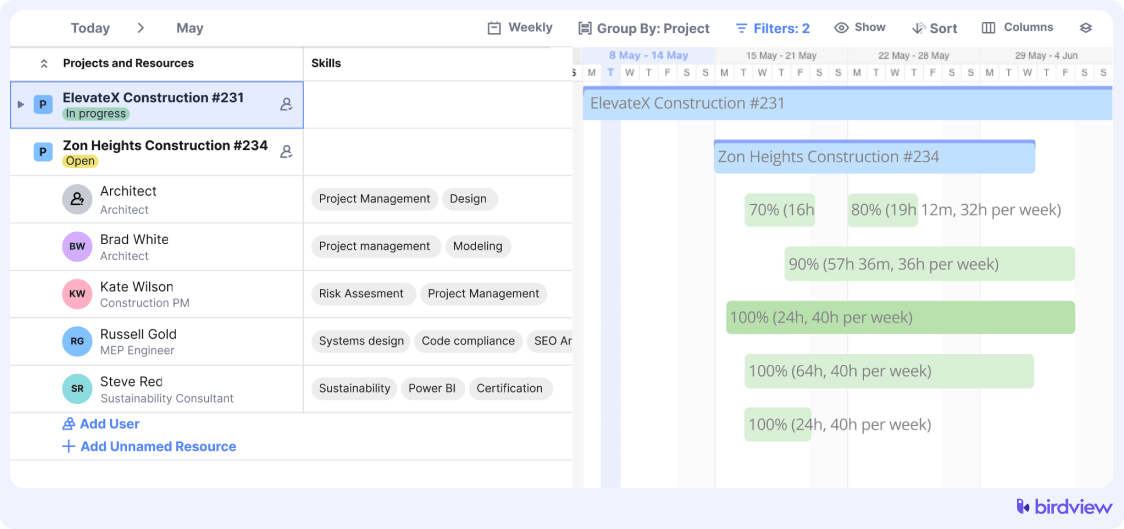 2. Level and smooth resources
2. Level and smooth resources
Implement resource leveling and smoothing to balance the workload across your team and timeline. Resource leveling involves adjusting the project schedule to address resource overloads, and ensuring that no team member is overburdened. Resource smoothing, on the other hand, focuses on optimizing resource allocation without extending the project timeline. For instance, you might shift non-critical tasks to periods of lower demand, ensuring a more even distribution of work and preventing burnout.
Resource leveling vs. smoothing (differences and application)
What is resource smoothing?
What is resource leveling?
3. Adopt flexible scheduling
Embrace flexible scheduling to adapt to changing circumstances and unexpected delays. Build some buffer time into your project timeline to accommodate unforeseen events or changes in resource availability. For example, if a key team member falls ill, having a flexible schedule allows you to reassign tasks without derailing the entire project. This approach helps maintain progress and reduces the pressure on your team to meet rigid deadlines.
4. Leverage technology and automation
Leverage technology and automation to streamline processes and reduce manual workload. Utilize project management software to track resource allocation, monitor progress, and automate routine tasks. For example, automated scheduling tools can help you adjust timelines and resource assignments quickly and accurately. This not only saves time but also ensures that your resources are used efficiently, allowing your team to focus on more strategic tasks.
“One of the most common challenges we see in project management is effectively managing resource constraints, especially in high-stakes industries like insurance. By leveraging advanced resource management tools and implementing proactive planning strategies, we’ve seen significant improvements in project timelines and outcomes. These tools not only help identify resource constraints early but also offer solutions to mitigate their impact, ensuring smoother project execution and ultimately, greater success.”
Ilda Cairns, Vice President at VCA Software – an intuitive and secure cloud-based claims management software.
Tips to avoid resource constraints
Resource constraints in project management can be a major headache, causing delays and adding stress. However, there are practical steps you can take to avoid these issues before they arise. Here are some valuable tips to help you steer clear of resource constraints, so you can focus on delivering successful outcomes with less stress.
💡 Proactively plan your resources well in advance
Anticipate potential issues and address them before they become problems. Start by clearly defining your project‘s scope, objectives, and resource requirements. Create detailed project plans that outline each phase, including timelines, resource allocations, and contingency plans. For instance, consider potential risks and develop backup plans for key resources, ensuring you’re prepared for any surprises.
💡 Monitor your resource usage regularly
Stay on top of any changes or emerging constraints. Establish a system for tracking resource allocation and consumption and conduct periodic reviews to identify any discrepancies. For example, use project management software to generate reports on resource utilization, allowing you to spot trends and address issues early. This continuous oversight helps you make timely adjustments and prevents resource shortages from catching you off guard.
💡 Maintain open and effective communication with your team and stakeholders
Ensure everyone is aware of resource needs and constraints. Encourage regular updates and feedback, fostering a collaborative environment where potential issues can be identified and addressed quickly. For example, hold weekly meetings to discuss resource status and any upcoming changes, ensuring that everyone is on the same page and can contribute to problem-solving efforts.
💡 Invest in training and development for your team
Enhance your team skills and reduce dependency on specific individuals. By ensuring that multiple team members can handle key tasks, you mitigate the risk of resource constraints due to skill shortages. For instance, offer cross-training opportunities and professional development programs to build a versatile team capable of adapting to various project demands. This approach not only improves resource availability but also boosts overall team performance.
How resource management software helps with resource constraints
Project and resource management software can be a game-changer, helping you manage everything more efficiently. With tools like Birdview, you can gain real-time insights, automate processes, and keep your project on track.
These are only a few of Birdivew‘s features that can help you tackle resource constraints head-on, making your project management experience smoother and more effective. To see these and other Birdivew‘s features in action, sign up for a free trial today or schedule a demo.
- Real-time tracking
Use real-time tracking features to monitor resource usage and availability continuously. Birdview allows you to see how resources are being allocated and used at any moment, helping you make informed decisions quickly. For example, if you notice a team member is overbooked, you can reassign tasks immediately to balance the workload. This proactive approach helps you avoid bottlenecks and ensures that resources are optimally utilized.
- Automated scheduling
Leverage automated scheduling to streamline your project timelines and resource assignments. Birdview‘s automated scheduling tools can adjust your project plan dynamically, accommodating changes in resource availability without manual intervention. For instance, if a key resource becomes unavailable, the software can automatically reschedule tasks and allocate other resources, ensuring that your project stays on track despite disruptions.
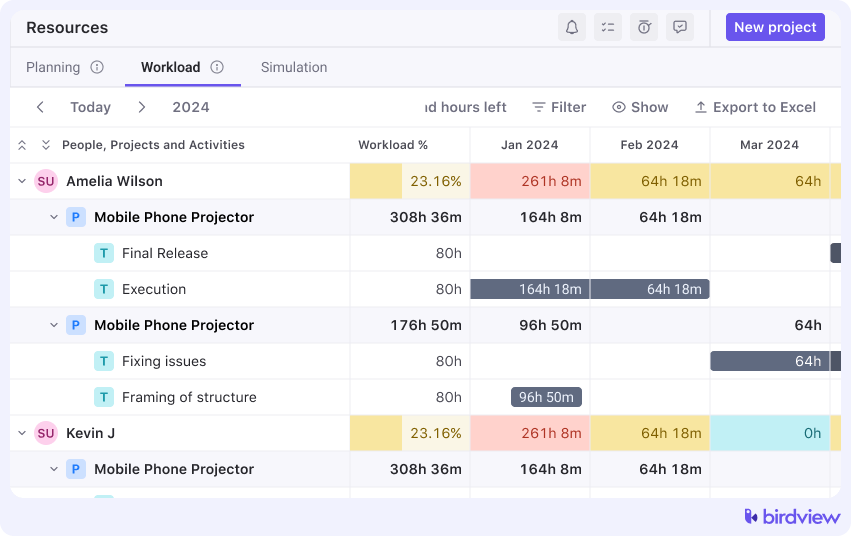
- Data-driven insights
Access data-driven insights to understand resource patterns and anticipate future needs. Birdview provides detailed reports and analytics on resource usage, helping you identify trends and potential issues before they become critical. For example, you can analyze historical data to predict peak periods of resource demand and plan accordingly, ensuring you have the necessary resources when you need them most.
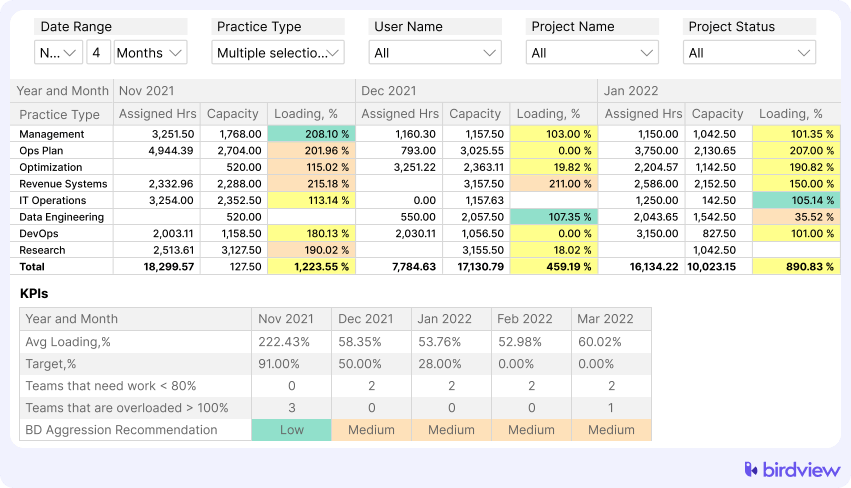
- Enhanced collaboration
Foster enhanced collaboration among your team with integrated communication tools. Birdview offers features like shared dashboards, task comments, and file sharing, ensuring everyone is on the same page. This level of collaboration helps you manage resources more effectively, as team members can easily communicate their needs and updates. For instance, a team member can flag a resource shortage immediately, allowing you to address the issue promptly.
- Resource booking
Book critical resources for your projects in advance with Birdview to ensure they will be available when needed. This helps you match capacity with demand, avoid delays, and streamline your resource planning. Eliminating overbooking and double-booking can also ensure smoother project execution.
- Resource utilization control
Review your planned resource allocation against current resource utilization with Birdview‘s resource allocation tool. Make necessary adjustments to optimize resource allocation based on real-time information, ensuring smoother project execution and maintaining a balanced workload for your resources.
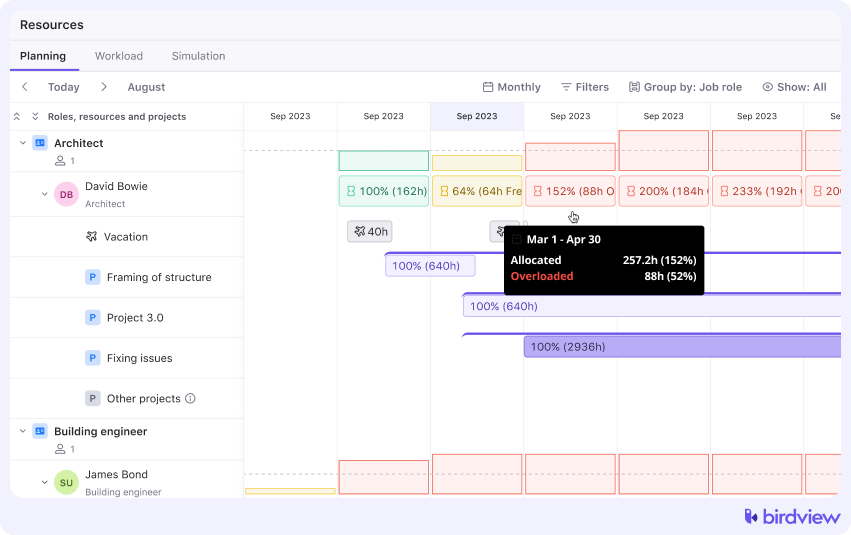
- “Find a candidate” feature
Using Birdview’s AI assistant, you can assemble a team that perfectly matches project requirements. Choose the best-fitting candidates by job roles, skill sets, availability, and hourly rates, and book resources needed for your project in advance to ensure successful delivery.
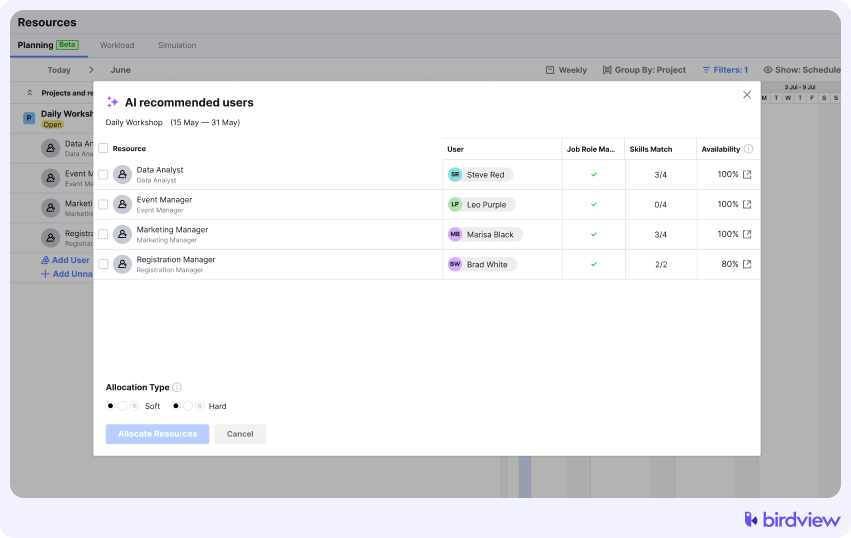
Resource constraints FAQs
1. What are the key indicators that my project is about to face a resource constraint?
Key indicators include rising overtime hours for team members, delays in task completion, increased budget expenditures without corresponding progress, and frequent changes to the project schedule due to unavailable resources.
2. What role does contingency planning play in managing resource constraints?
Contingency planning is crucial for managing resource constraints. It involves preparing backup plans and alternative strategies to address potential resource shortages or disruptions. This proactive approach ensures that the project can continue progressing even when unexpected issues arise.
3. How can resource constraints impact project quality, and how do I mitigate these effects?
Resource constraints can lead to rushed work, cutting corners, and ultimately, lower quality deliverables. Mitigate these effects by maintaining a focus on critical quality standards, ensuring that key tasks receive adequate resources, and using quality management tools to monitor outcomes throughout the project lifecycle.
4. What are some common mistakes in resource planning that lead to constraints?
Common mistakes include underestimating resource needs, failing to account for resource availability, not involving key stakeholders in planning, and neglecting to update the resource plan regularly. Avoid these pitfalls by thorough planning, stakeholder engagement, and continuous monitoring and adjustments.

